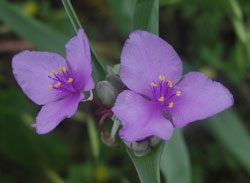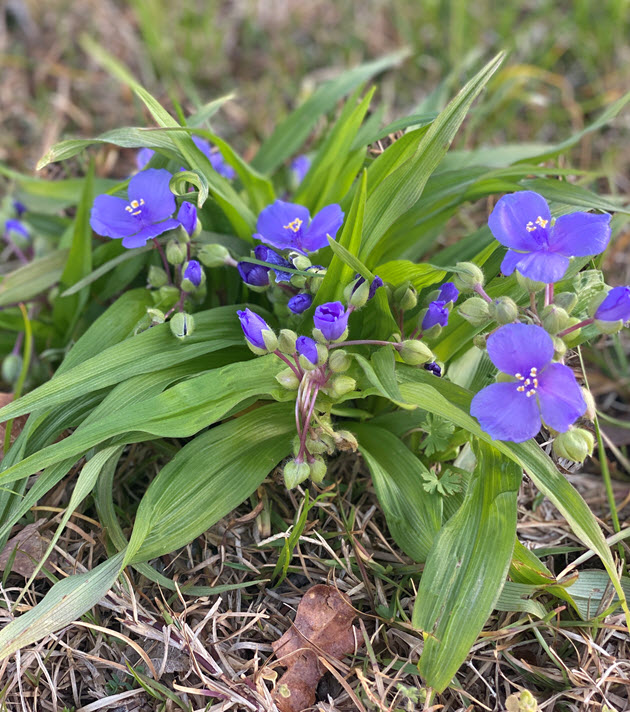Resource Library
Plant of the Week: Spiderwort is an Arkansas perennial | Spring perrenial spiderwort
The University of Arkansas System Division of Agriculture does not promote, support or recommend plants featured in "Plant of the Week." Please consult your local Extension office for plants suitable for your region.
Plant of the Week
Spiderwort
Latin: Tradescantia ohiensis

Wildflowers come into our gardens of their own accord or, more often, we plant them.
Occasionally, common wildflowers will be taken up by a plant breeder and become part of the mélange of plants grown in the nursery trade. That is now happening with Tradescantia, the common spiderwort growing in moist woodlands throughout the eastern states.
What are the characteristics of spiderwort?
- Spiderworts are bewilderingly similar in appearance with at least 20 species described in North America and a dozen found in Arkansas.
- The most widely distributed Arkansas species is T. ohiensis, which grows as much as 30 inches tall with several erect branches ascending from a central crown. The branches are sheathed up the stem with linear, succulent, foot-long leaves.
- Tradescantias are spring ephemerals, disappearing by late June as the summer heats up. All parts of the plant contain a thick, mucilaginous sap.
- The characteristic three-petaled spiderwort flowers are produced in a terminal cluster in shades of purple, blue, pink or white from mid spring till early summer. Flowers last but a single day, but plants continue to bloom for two to three weeks.
- Spiderwort has a history of confusion and misidentification. Surprisingly, it was one of the earliest New World plants introduced to Europe, primarily because it was mistaken for a plant Algonquin Indians used in weaving.

This photo of spiderwort was taken by Amy Cole, Extension Digital Media Program Manager in Hot Springs, Arkansas.
The second misidentification came when early 17th century botanists began classifying plants. Spiderwort is named after John Tradescant Sr. (d. 1638), the head gardener for King Charles I of England. As a subscriber to the Virginia Co., Tradescant received shipments of a number of American plants, including the Virginia spiderwort. On page 49 of his 1633 Herbal, John Gerard illustrates with a block cut print a plant he calls “Phalangium Virginianum Tradescanti,” giving as its common English name “Tradescants Virginian Spiderwort.”
It’s the spiderwort we know today as T. virginiana.
Gerard illustrates four other spiderworts, none of which are related to the plant we know today by that name. Reading his discussion of “the vertues” of using these plants, we find they are to be ground up and mixed with ale to protect against the bite of a Phalangium spider. Phalangium spiders, it turns out, are non-venomous and are commonly called harvester spiders, the most common being Daddy-longlegs.
Mixing spiderworts with ale was a good excuse for a midsummer drinking binge to help ward off “dancing madness,” a common problem in rural areas. Afflicted people had headaches, sweating, trembling and twitching. The problem was probably caused by ergot-infected rye but spider bights were blamed. Patients who imbibed the spiderwort infused ale twitched and danced about the villages until the effects of ergot poisoning or the alcohol wore off.
When Linnaeus unified plant classification a century later, he named the plant after the senior Tradescant and retained the common name Gerard first used, even though it was not the “spiderwort” actually mixed with the ale.
Is spiderwort easy to grow in my garden?
Spiderworts are easy to grow in gardens in moist, partially shaded to sunny locations. Trim them back as the foliage begins to decline and before seeds have a chance to form. Reseeding can become a problem in the garden.
Several cultivars of Tradescantia are now offered by nurserymen.
By: Gerald Klingaman, retired
Extension Horticulturist - Ornamentals
Extension News - June 23, 2006
The University of Arkansas System Division of Agriculture does not maintain lists of retail outlets where these plants can be purchased. Please check your local nursery or other retail outlets to ask about the availability of these plants for your growing area.